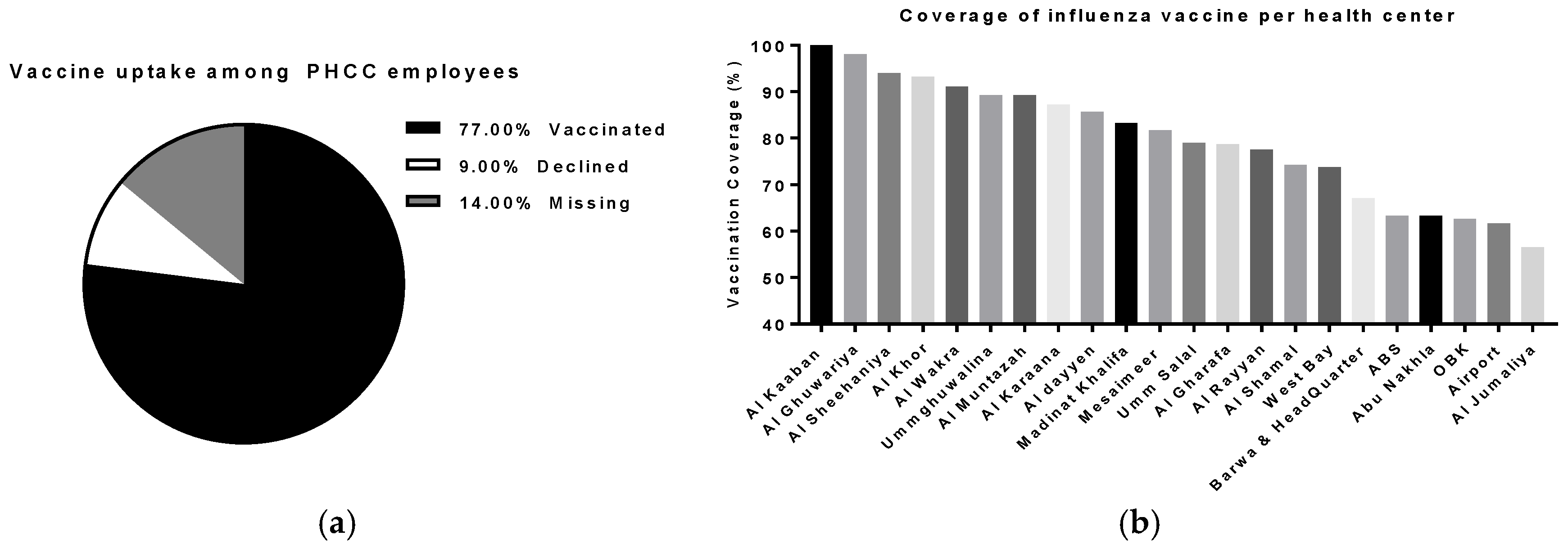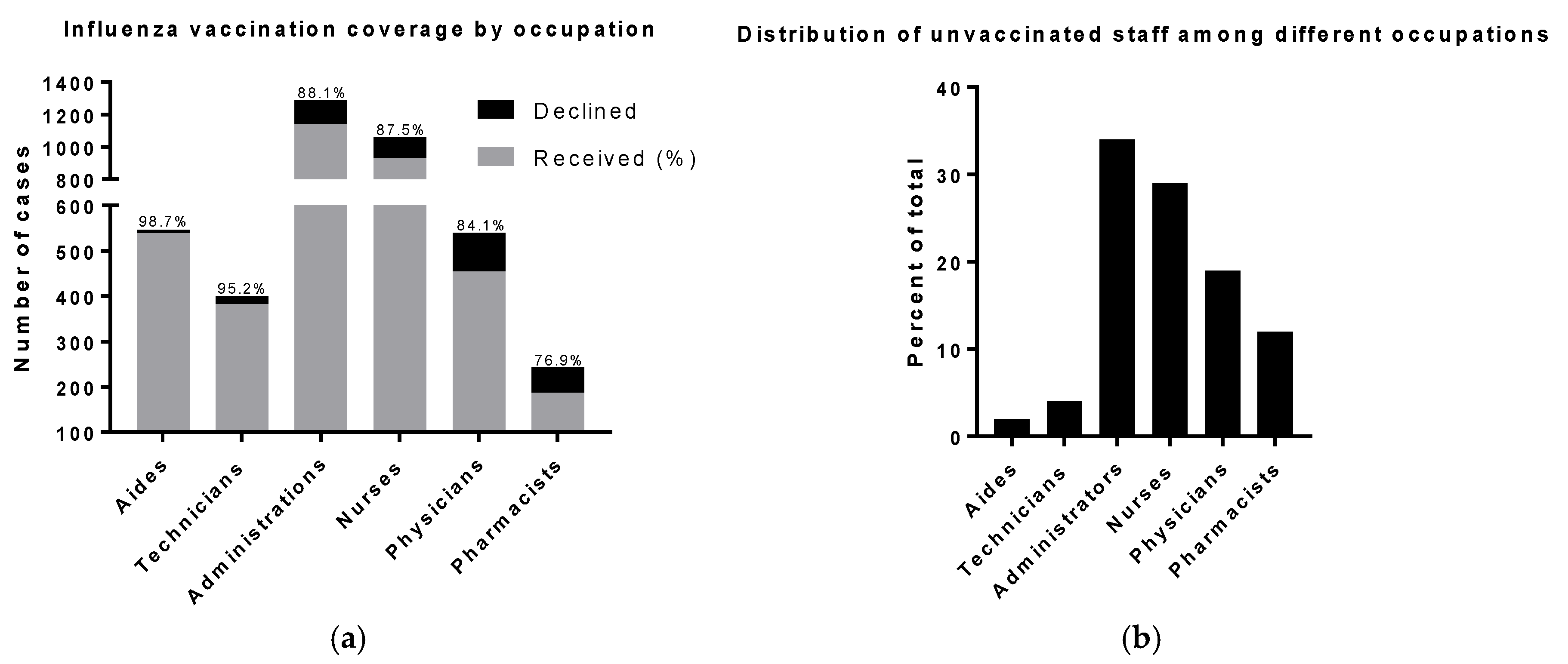Improving Influenza Vaccination Rate among Primary Healthcare Workers in Qatar
Abstract
:1. Introduction
2. Materials and Methods
3. Results
4. Discussion
5. Conclusions
Acknowledgments
Author Contributions
Conflicts of Interest
References
- Yassine, H.M.; Lee, C.W.; Gourapura, R.; Saif, Y.M. Interspecies and intraspecies transmission of influenza A viruses: Viral, host and environmental factors. Anim. Health Res. Rev. 2010, 11, 53–72. [Google Scholar] [CrossRef] [PubMed]
- Voirin, N.; Barret, B.; Metzger, M.H.; Vanhems, P. Hospital-acquired influenza: A synthesis using the Outbreak Reports and Intervention Studies of Nosocomial Infection (ORION) statement. J. Hosp. Infect. 2009, 71, 1–14. [Google Scholar] [CrossRef] [PubMed]
- Music, T. Protecting patients, protecting healthcare workers: A review of the role of influenza vaccination. Int. Nurs. Rev. 2012, 59, 161–167. [Google Scholar] [CrossRef] [PubMed]
- Asma, S.; Akan, H.; Uysal, Y.; Poçan, A.G.; Sucaklı, M.H.; Yengil, E.; Gereklioğlu, Ç.; Korur, A.; Başhan, İ.; Erdogan, A.F.; et al. Factors effecting influenza vaccination uptake among health care workers: A multi-center cross-sectional study. BMC Infect. Dis. 2016, 16, 192. [Google Scholar] [CrossRef] [PubMed]
- Alkuwari, M.G.; Aziz, N.A.; Nazzal, Z.A.; Al-Nuaimi, S.A. Pandemic influenza A/H1N1 vaccination uptake among health care workers in Qatar: Motivators and barriers. Vaccine 2011, 29, 2206–2211. [Google Scholar] [CrossRef] [PubMed]
- Honda, H.; Sato, Y.; Yamazaki, A.; Padival, S.; Kumagai, A.; Babcock, H. A successful strategy for increasing the influenza vaccination rate of healthcare workers without a mandatory policy outside of the United States: A multifaceted intervention in a Japanese tertiary care center. Infect. Control Hosp. Epidemiol. 2013, 34, 1194–1200. [Google Scholar] [CrossRef] [PubMed]
- Heinrich-Morrison, K.; McLellan, S.; McGinnes, U.; Carroll, B.; Watson, K.; Bass, P.; Worth, L.J.; Cheng, A.C. An effective strategy for influenza vaccination of healthcare workers in Australia: Experience at a large health service without a mandatory policy. BMC Infect. Dis. 2015, 15, 42. [Google Scholar] [CrossRef] [PubMed]
- Abu-Gharbieh, E.; Fahmy, S.; Rasool, B.A.; Khan, S. Influenza vaccination: Healthcare workers attitude in three Middle East countries. Int. J. Med. Sci. 2010, 7, 319–325. [Google Scholar] [CrossRef] [PubMed]
- Alshammari, T.M.; AlFehaid, L.S.; AlFraih, J.K.; Aljadhey, H.S. Health care professionals’ awareness of, knowledge about and attitude to influenza vaccination. Vaccine 2014, 32, 5957–5961. [Google Scholar] [CrossRef] [PubMed]
- Black, C.L.; Xue, X.; Ball, S.W.; Donahue, S.M.A.; Izrael, D.; de Perio, M.A.; Laney, A.S.; Williams, W.W.; Lindley, M.C.; Graitcer, S.B.; et al. Influenza Vaccination Coverage among Health Care Personnel—United States, 2014–2015 Influenza Season. Morb. Mortal. Wkly. Rep. 2015, 64, 993–999. [Google Scholar] [CrossRef] [PubMed]
- Black, C.L.; Xue, X.; Ball, S.W.; Donahue, S.M.A.; Izrael, D.; de Perio, M.A.; Laney, A.S.; Lindley, M.C.; Graitcer, S.B.; Lu, P.; et al. Influenza vaccination coverage among health care personnel—United States, 2013–2014 influenza season. Morb. Mortal. Wkly. Rep. 2014, 63, 805–811. [Google Scholar]
- Alhammadi, A.; Khalifa, M.; Abdulrahman, H.; Almuslemani, E.; Alhothi, A.; Janahi, M. Attitudes and perceptions among the pediatric health care providers toward influenza vaccination in Qatar: A cross-sectional study. Vaccine 2015, 33, 3821–3828. [Google Scholar] [CrossRef] [PubMed]
- Salgado, C.D.; Giannetta, E.T.; Hayden, F.G.; Farr, B.M. Preventing nosocomial influenza by improving the vaccine acceptance rate of clinicians. Infect. Control Hosp. Epidemiol. 2004, 25, 923–928. [Google Scholar] [CrossRef] [PubMed]
- National Vaccine Advisory Committee. Strategies to achieve the healthy people 2020 annual influenza vaccine coverage goal for health-care personnel: Recommendations from the national vaccine advisory committee. Public Health Rep. 2013, 128, 7–25. [Google Scholar]


| PHCC Employees Location | Percent Given (No.) |
|---|---|
| Airport | 61.6 (153) |
| Ummghuwalina | 89.3 (193) |
| Al Wakra | 91.1 (237) |
| Al Muntazah | 89.2 (224) |
| West Bay | 73.8 (178) |
| Al Ghuwariya | 98.1 (52) |
| Al Shamal | 74.2 (95) |
| Al Khor | 93.3 (141) |
| Al Rayyan | 77.6 (118) |
| Al Karaana | 87.2 (41) |
| Al Sheehaniya | 94 (175) |
| Abu Nakhla | 63.3 (128) |
| OBK | 62.6 (168) |
| Al dayyen | 85.7 (120) |
| Umm Salal | 79 (151) |
| Al Gharafa | 78.7 (211) |
| Al Kaaban | 100 (36) |
| Madinat Khalifa | 83.3 (221) |
| Al Jumaliya | 56.5 (13) |
| Barwa & Head Quarter | 67.1 (557) |
| ABS | 63.3 (180) |
| Mesaimeer | 81.7 (237) |
| Average (Total) | 79.5 (3629) |
| Occupation | Percent Given (No.) | Odds Ratio a | 95% CI b | p Value |
|---|---|---|---|---|
| Aide | 98.7 (539) | 11.1 | 5.4–23.4 | <0.0001 |
| Administration | 88.1 (1138) | 0.9 | 0.73–1.1 | ns |
| Technician | 95.2 (382) | 2.7 | 1.7–4.3 | <0.0001 |
| Nurse | 87.6 (929) | 0.8 | 0.3–1.0 | ns |
| Physician | 84.1 (454) | 0.6 | 0.5–0.8 | 0.0002 |
| Pharmacist | 76.9 (187) | 0.4 | 0.3–0.5 | <0.0001 |
| Average (Total) | 88.9 (3629) |
| Reason | Occupation | |||||
|---|---|---|---|---|---|---|
| Aide | Admin | Technician | Nurse | Physician | Pharmacist | |
| No reason provided | 71.4 (5) | 54.3 (83) | 5.3 (1) | 24.2 (32) | 32.6 (28) | 14.3 (8) |
| To avoid side effects | 14.3 (1) | 6.5 (10) | 5.3 (1) | 9.8 (13) | 16.3 (14) | 12.5 (7) |
| Vaccinated previous year | 0 (0) | 7.8 (12) | 26.3 (5) | 28.8 (38) | 15.1 (13) | 5.4 (3) |
| Behavior | 0 (0) | 14.4 (22) | 36.8 (7) | 7.6 (10) | 19.8 (17) | 48.2 (27) |
| Sick | 0 (0) | 3.3 (5) | 10.5 (2) | 9.1 (12) | 4.7 (4) | 3.6 (2) |
| Pregnant | 0 (0) | 6.5 (10) | 0 (0) | 10.6 (14) | 4.7 (4) | 7.1 (4) |
| Egg allergy | 14.3 (1) | 5.2 (8) | 15.8 (3) | 4.5 (6) | 5.8 (5) | 8.9 (5) |
| On treatment | 0 (0) | 1.3 (2) | 0 (0) | 1.5 (2) | 1.2 (1) | 0 (0) |
| Breast feeding | 0 (0) | 0.7 (1) | 0 (0) | 3.8 (5) | 0 (0) | 0 (0) |
| Total Percent (N) | 100 (7) | 100 (153) | 100 (19) | 100 (132) | 100 (86) | 100 (56) |
© 2017 by the authors. Licensee MDPI, Basel, Switzerland. This article is an open access article distributed under the terms and conditions of the Creative Commons Attribution (CC BY) license (http://creativecommons.org/licenses/by/4.0/).
Share and Cite
Elawad, K.H.; Farag, E.A.; Abuelgasim, D.A.; Smatti, M.K.; Al-Romaihi, H.E.; Al Thani, M.; Al Mujalli, H.; Shehata, Z.; Alex, M.; Al Thani, A.A.; et al. Improving Influenza Vaccination Rate among Primary Healthcare Workers in Qatar. Vaccines 2017, 5, 36. https://doi.org/10.3390/vaccines5040036
Elawad KH, Farag EA, Abuelgasim DA, Smatti MK, Al-Romaihi HE, Al Thani M, Al Mujalli H, Shehata Z, Alex M, Al Thani AA, et al. Improving Influenza Vaccination Rate among Primary Healthcare Workers in Qatar. Vaccines. 2017; 5(4):36. https://doi.org/10.3390/vaccines5040036
Chicago/Turabian StyleElawad, Khalid H., Elmoubasher A. Farag, Dina A. Abuelgasim, Maria K. Smatti, Hamad E. Al-Romaihi, Mohammed Al Thani, Hanan Al Mujalli, Zienab Shehata, Merin Alex, Asmaa A. Al Thani, and et al. 2017. "Improving Influenza Vaccination Rate among Primary Healthcare Workers in Qatar" Vaccines 5, no. 4: 36. https://doi.org/10.3390/vaccines5040036





